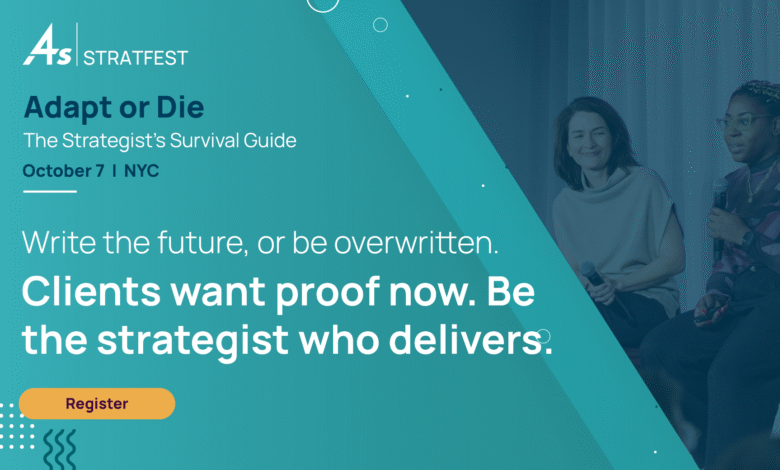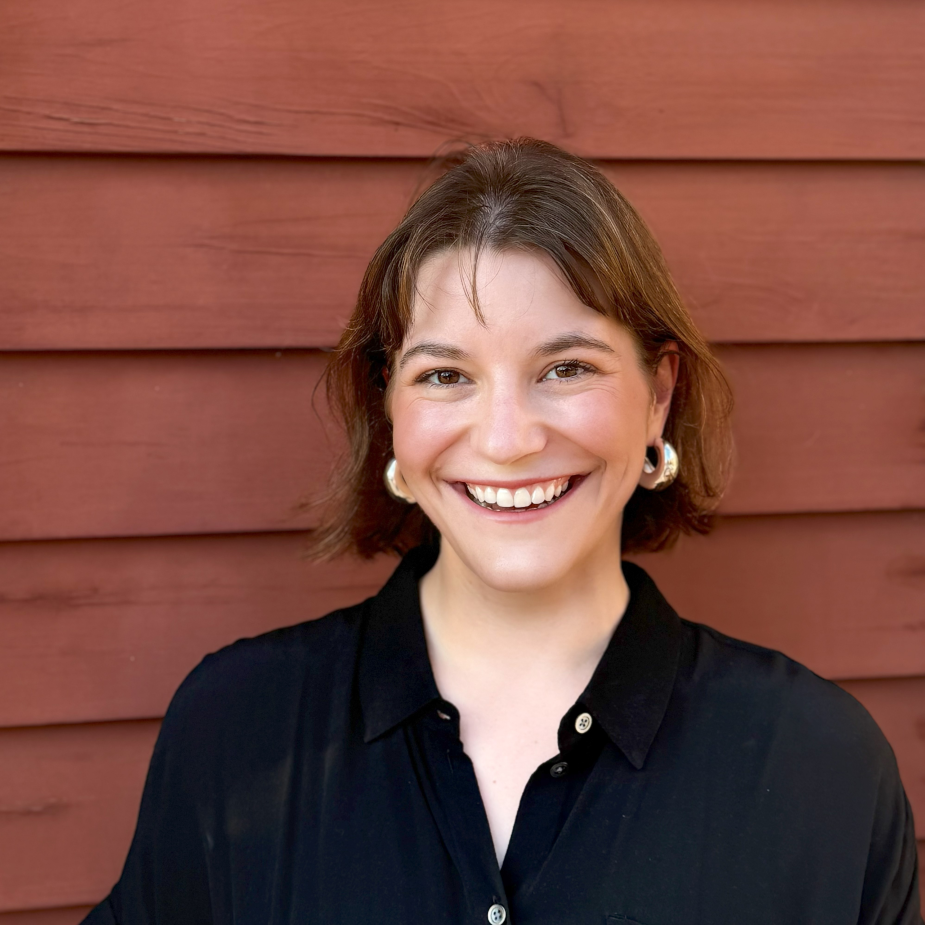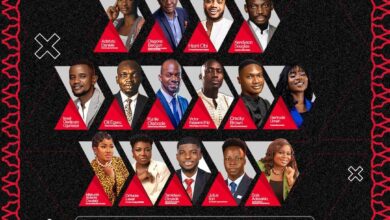Sharp, Bold and Candid: Meet the Rising Voices Shaping the Future of Strategy

We live in times when strategy is being rewritten in real time. AI accelerates everything. Creatives challenge the brief and platforms change the game faster than agencies can keep up. In this climate, strategists must think forward to survive and thrive.
Which is why 4As StratFest 2025: Adapt or Die (October 7th, NYC) is a wake-up call. A survival guide. A place for strategists to confront what’s shifting, sharpen the fundamentals that still matter and build what’s next.
The night before, on October 6th, the Jay Chiat Awards spotlight the ideas and insights moving the industry forward. These separate yet complementary events are central to what happens next in strategy. One celebrates the craft. The other equips strategists to evolve it.
Part one of this series celebrated the visionary veterans who’ve redefined what strategy can be. Part two now turns the spotlight toward those redefining where it’s headed next. In this edition, some of the Jay Chiat Emerging Strategist nominees for 2025 share bold, honest perspectives that are helping move the craft forward. It’s evident they’re already reshaping the discipline with a fresh outlook, sharp instincts and a refusal to play by outdated rules.
These rising strategists speak candidly about the myths they’re challenging, how they stay grounded in an industry addicted to noise and the hard truths that often go unsaid.
It is worth noting that this evolution is not just theoretical. Last year’s winning emerging strategist Hannah Schweitzer, associate strategy director at TBWA\Chiat\Day returns to the stage this year, now as a featured speaker at StratFest. It’s a powerful reminder that the next generation of strategy leaders is already making their mark.
Now’s the time to secure your seat at the Jay Chiat Awards to see who wins and at StratFest to hear from the best.
Listen to the voices shaping what’s ahead.
Q> In a world flooded with data, noise and trends, what keeps your thinking clear?
Alex Mason, director, strategy, VML
The biggest way to think clearly about the world is to be an active participant in it. You have to get out from behind the four-corners of your screen and into the world. By the time you see something on TikTok it’s already a trend that will die very soon (remember when we were all saying demure?). To spot what’s on the horizon you have to go outside and look at the horizon. This can look different for everyone. For me, it’s a mix of a few things: spending time with people I love, reading a ton — I read every single night, and it’s such an easy, inexpensive way to travel the world, meet new people, and put yourself in someone else’s shoes (it’s also so satisfying to end the day with a book in bed instead of a phone). And lastly, spending time outside with no distractions. I grew up in the mountains of Colorado. My house backed up to the National Forest. Nothing returns me to the centre quicker than a hike (or a walk, now that I’m in the city).
Hannah Coursey, strategist, GSD&M

Consistently writing, even when my sentences are less than perfect. Writing helps me connect to my opinion, which is how I make sense of the data, noise and trends.
Madison Giller, strategy director, Arnold Worldwide

As an 85-year-old Millennial at heart, I process the world better through tactile things. They let me absorb ideas almost by osmosis. Recently, I snagged a few old award archive books from D&AD and The One Show (indeed, I am a nerd). Learning from people whose work was worthy enough to be immortalised in print is priceless. There’s a timelessness to it that transcends trends. It’s a reminder that your outputs are only as strong as your inputs, and the more I immerse myself in thoughtfully crafted work, the clearer my thinking becomes.
Mike Shirdan, social media strategist, Betty

I stay deeply in it when it comes to social media. Immersing myself in niche communities, creator trends and platform data helps me spot the signals behind the noise. For example, seeing creators mix lo-fi authenticity with hi-fi polish in a single video points to how audiences want both intimacy and craft. My strategies follow these cultural cues so brands can speak with consumers, not at them and ultimately stay ahead of where attention is moving next.
Q> A belief or assumption in our industry you’ve challenged as a strategist
Hannah> You don’t have to study advertising in college to work in advertising. In fact, some of the best strategists have been known to study something completely unrelated to advertising, choosing a subject that allows them to question and build their own unique worldview.
Madison> In a world of uncertainty, the industry has doubled down on data, logic and reason. But culture has gone the opposite way – leaning harder into fantasy, mysticism and the irrational. From Etsy witches to Romantasy #BookTok to GLP-1 formulas and crypto astrologers, people are buying into magic over logic. Over-rationalising creativity to death risks stripping away what people are actually craving: emotion, magnetism and a little bit of magic. Great strategy balances logic and magic to enable creative leaps.
Mike> As a social media strategist, I push back on the idea that short attention spans kill long-form content. The truth is, people will spend minutes or even hours with content that earns their time. We’ve seen this with brands leaning into creator-led storytelling on platforms like TikTok and YouTube, where episodes and series keep audiences coming back. The real challenge isn’t attention spans. It’s creating strategy and creative strong enough to hold attention in a crowded feed.
Q> An uncomfortable truth about strategy more people need to hear
Hannah> No framework, no formula, no data point will make you a good strategist. Sure, being a strategist demands hard skills, but it’s often the soft skills that make you indispensable, and they’re also the hardest to master.
Madison> The fun gets sucked out of strategy when we treat it like a math problem. There isn’t a single ‘right’ answer to find. Approach it like creativity: experiment, iterate and explore widely before committing. That’s why I start my process with breadth over depth – I don’t want to fall in love with the first solution that seems reasonable. You should get into a ‘situationship’ with a few strategies when you’re starting a brief. It’s about testing chemistry, not tying the knot.
Q> The first thing that comes to mind when you think of this year’s StratFest theme: Adapt or Die
Hannah> The strategy elephant in the room: AI. I imagine fears will be confronted and overdue conversations will be had. AI as a tool, not a replacement, right?
Madison> Channel your inner Olivia Pope (yes, the one from Scandal): make chaos work in your favour. Just like Olivia, strategists are asked to deliver certainty in the face of uncertainty. The survival guide? Roll with it. Embrace ambiguity, don’t fight it. Jiu-jitsu constraints into opportunities. Treat creativity as the ultimate form of resilience. Play, pivot, fail fast and make your own rules if the old rules don’t fit. Does that not sound like the entire 124-episode plot of Scandal?
Q> A moment that shifted how you think about strategy
Alex> There wasn’t a single lightning-bolt moment – it goes back to how I’ve been since I was little. I was that kid who loved school, not because of grades but because I liked learning just for the sake of it. That shapes how I approach strategy today: every project feels like a new class I get to dive into, and that keeps me in a beginner’s mindset. Instead of trying to have all the answers, I get to be curious and ask questions. I find a lot of joy in the act of discovering and feeling my brain work through new problems.
Q> A shift on the horizon people should be ready for
Alex> Older women are about to come into massive power. The largest wealth transfer in history is already underway, and they will be the primary beneficiaries.
By 2030, women will control more than half of global wealth (for the first time in EVER). In the US, baby boomers hold 70% of assets, most in joint households. As men pass, those assets will shift to their wives, who are often younger and almost always live longer. By the end of the decade, American women are expected to control much of the $30 trillion in boomer wealth – a sum that rivals the annual GDP of the United States.
And yet, advertisers remain fixated on youth. Women over 60 appear in less than 2% of ads. We obsess over gen z and now Gen Alpha, while ignoring the generation with the greatest financial power. Old is gold and brands are missing out.
Mike> The next big shift will be in how brands use AI thoughtfully rather than relying on it to do all the heavy lifting. AI-generated content can unlock speed and scale, but audiences are craving the human touch – the behind-the-scenes moments, the craft, the imperfections that make content feel real. The brands that will win aren’t the ones replacing creativity with AI, but the ones using AI to enhance human storytelling and push ideas further. That balance will be what separates cultural tastemakers from brands that blend into the algorithmic noise.
Up next: In Part three of this series, hear from some of the Jay Chiat Awards jurors and StratFest speakers.
Now is the time to secure your spot at StratFest, happening October 7th in NYC.




